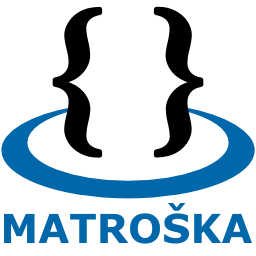Matroska
 | |
| Filename extension |
.mkv .mka |
|---|---|
| Internet media type | video/x-matroska audio/x-matroska |
| Developed by | Matroska.org |
| Type of format | Container format |
| Container for | Multimedia |
The Matroska Multimedia Container is an open standard free Container format, a file format that can hold an unlimited number of video, audio, picture or subtitle tracks inside a single file.[1] It is intended to serve as a universal format for storing common multimedia content, like movies or TV shows. Matroska is similar in conception to other containers like AVI, MP4 or ASF, but is completely open source. Matroska file types are .MKV for video (and audio) and .MKA for audio-only files.
Matroska is an English word derived from the Russian word "matryoshka" (Template:Lang-ru, IPA: [mɐˈtrʲoʂkə]), which means "nesting doll" (the common Russian egg-shaped doll within a doll). This is a play on the container (media within a form of media/doll within a doll) aspect of the matryoshka as it is a container for visual and audio data.
History
The project was announced on December 7 2002 as a fork of an earlier container format project, after disagreements with that project's creator about the use of the Extensible Binary Meta Language (EBML) instead of another binary format. The founders of the Matroska project believe that the use of EBML brings them a number of advantages, including making it easier to extend the format for decades into the future as new developments occur and/or as the project goals change.
Goals
With Matroska's roots in EBML it has been designed from the ground up for longevity and extendability (unlike formats such as AVI). The Matroska team has spoken openly on Doom9.org and hydrogenaudio.org about some of their long term goals to create a modern, flexible, extensible, cross-platform multimedia container format that can:
- develop robust streaming support;
- develop a "DVD-like" menu system based on EBML;
- develop a set of tools for the creation and editing of Matroska files;
- develop libraries that can be used to allow developers to add Matroska support to their applications;
- work with hardware manufacturers to include Matroska support in embedded multimedia devices;
- provide native Matroska support in various operating systems.
Software support
Listed below is software that has native Matroska support.
- ALShow
- Avidemux
- Azureus Vuze Media Player
- BS.Player
- Chameleo
- The Core Media Player
- CorePlayer Mobile
- The Core Pocket Media Player
- GOM Player
- Gstreamer-based Players (Totem, etc.)
- HandBrake
- jetAudio
- Kaffeine
- The KMPlayer
- Media Player Classic
- MediaPortal [2]
- Mezzmo Media Player
- MPlayer
- MythTV
- Totem Movie Player
- VirtualDubMod
- VLC media player
- VSO Software
- Xbox Media Center
- xine
- Zoom Player
- Perian Quicktime Plugin for Mac OS X [3]
Content in Matroska
Initially the uptake of the format was low. It was initially used almost exclusively for DVD rips of anime, as the container allowed the viewer to choose between the original language track and a dub. In recent years however Matroska sees wider use due to The Scene adopting it as a format of choice for high definition content ripped from HDTV and next generation video discs (HD DVD and Blu-ray). It usually carries H.264 video, AC3/AAC/DTS (also multiple) audio tracks and sometimes subtitle tracks. Before H.264, most MKV files from the above mentioned scene were holding RealVideo (RV9, RV10) encoded video tracks, which at that time was slightly superior to MPEG-4 Part 2[citation needed] (used e.g. by the DivX and Xvid codecs), especially for anime material, in combination with MP3 or Vorbis encoded audio streams and soft-subtitles.[citation needed]
License
Matroska is an open standards project. This means it is free to use, and that the technical specifications describing the bit stream are open to everybody, even to companies that would like to support it in their products. The source code of the libraries developed by the Matroska Development Team is licensed under GNU LGPL. In addition to that, there are also free parsing and playback libraries available under the BSD license, for proprietary software adoption.
Criticisms of Matroska
Matroska has received a great deal of criticism in online movie and anime communities for being poorly optimized and too tolerant of poor encoding practices and file corruption, thus often requiring excessive processor usage for playback in supporting software, compared to other MPEG-4 containers. Its (see Comparison of container formats) feature creep, leading to a large list of obscure features and lack of standardization also means it still has no specific hardware decoder support despite 6 years of development, and cannot be played back on consumer electronics devices such as DVD players. Competing containers such as Divx, AVI and MP4 have produced widespread support among set-top PVRs, HDD-based media players, home and portable game consoles and portable media players in this timeframe.
See also
- LiVES
- Comparison of container formats
- Open source codecs and containers
- Combined Community Codec Pack
References
- ^ Matroska Format Specifications, Matroska.org.
- ^ MediaPortal Features (01/01/2007)
- ^ Perian details
External links
- Official Matroska Homepage
- Technical specifications for the Matroska Container Format
- Proposed RFC
- CoreCodec – Official Matroska Developer Project Home
- Perian (MKV) QuickTime Component For Mac
- Haali Media splitter
- Project Announcement on Doom9 forums
- Parser, de-/muxer and player
- Linux and Windows tools for Matroska
- The XviD-Ogg-MKV Walkthrough – Step-by-step instructions for MKV encoding in Microsoft Windows
